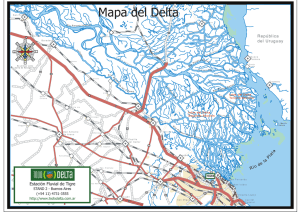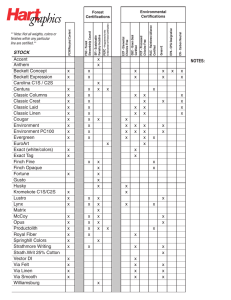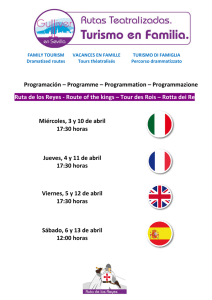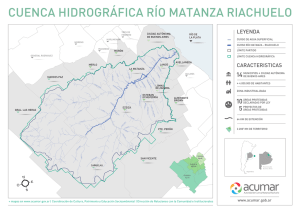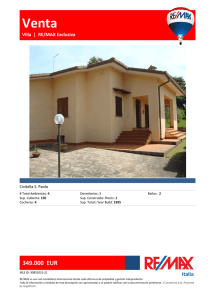Descargar – Inglés - Red Cántabra de Desarrollo Rural
Anuncio
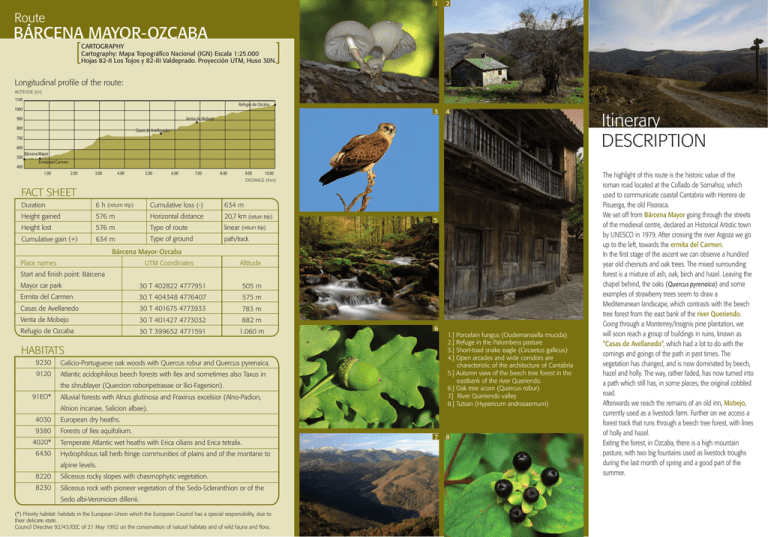
1 2 3 4 Route BÁRCENA MAYOR-OZCABA CARTOGRAPHY Cartography: Mapa Topográfico Nacional (IGN) Escala 1:25.000 Hojas 82-II Los Tojos y 82-III Valdeprado. Proyección UTM, Huso 30N. Longitudinal profile of the route: ALTITUDE (m) 1100 Refugio de Ozcaba 1000 Venta de Mobejo 900 800 Casas de Avellanedo 700 600 500 400 Bárcena Mayor Itinerary DESCRIPTION Ermita del Carmen 1.00 2.00 3.00 4.00 5.00 6.00 7.00 8.00 9.00 10.00 DISTANCE (Km) FACT SHEET Duration 6 h (return trip) Cumulative loss (-) 634 m Height gained 576 m Horizontal distance 20,7 km (return trip) Height lost 576 m Type of route linear (return trip) Cumulative gain (+) 634 m Type of ground path/track 5 Bárcena Mayor-Ozcaba Place names UTM Coordinates Altitude Start and finish point: Bárcena Mayor car park 30 T 402822 4777951 Ermita del Carmen 30 T 404348 4776407 575 m Casas de Avellanedo 30 T 401675 4773933 783 m Venta de Mobejo 30 T 401427 4773032 882 m Refugio de Ozcaba 30 T 399652 4771591 1.060 m 505 m 6 HABITATS 9230 Galicio-Portuguese oak woods with Quercus robur and Quercus pyrenaica. 9120 Atlantic acidophilous beech forests with Ilex and sometimes also Taxus in the shrublayer (Quercion roboripetraeae or Ilici-Fagenion). 91EO* Alluvial forests with Alnus glutinosa and Fraxinus excelsior (Alno-Padion, Alnion incanae, Salicion albae). 4030 European dry heaths. 9380 Forests of Ilex aquifolium. 4020* 6430 Temperate Atlantic wet heaths with Erica ciliaris and Erica tetralix. Hydrophilous tall herb fringe communities of plains and of the montane to alpine levels. 8220 Siliceous rocky slopes with chasmophytic vegetation. 8230 Siliceous rock with pioneer vegetation of the Sedo-Scleranthion or of the Sedo albi-Veronicion dillenii. (*) Priority habitat: habitats in the European Union which the European Council has a special responsibility, due to their delicate state. Council Directive 92/43/EEC of 21 May 1992 on the conservation of natural habitats and of wild fauna and flora. 7 1.] Porcelain fungus (Oudemansiella mucida) 2.] Refuge in the Palombera pasture 3.] Short-toad snake eagle (Circaetus gallicus) 4.] Open arcades and wide corridors are characteristic of the architecture of Cantabria 5.] Autumn view of the beech tree forest in the eastbank of the river Queriendo. 6.] Oak tree acorn (Quercus robur) 7.] River Queriendo valley 8.] Tutsan (Hypericum androsaemum) 8 The highlight of this route is the historic value of the roman road located at the Collado de Somahoz, which used to communicate coastal Cantabria with Herrera de Pisuerga, the old Pisoraca. We set off from Bárcena Mayor going through the streets of the medieval centre, declared an Historical Artistic town by UNESCO in 1979. After crossing the river Argoza we go up to the left, towards the ermita del Carmen. In the first stage of the ascent we can observe a hundred year old chesnuts and oak trees. The mixed surrounding forest is a mixture of ash, oak, birch and hazel. Leaving the chapel behind, the oaks (Quercus pyrenaica) and some examples of strawberry trees seem to draw a Mediterranean landscape, which contrasts with the beech tree forest from the east bank of the river Queriendo. Going through a Monterrey/Insignis pine plantation, we will soon reach a group of buildings in ruins, known as “Casas de Avellanedo”, which had a lot to do with the comings and goings of the path in past times. The vegetation has changed, and is now dominated by beech, hazel and holly. The way, rather faded, has now turned into a path which still has, in some places, the original cobbled road. Afterwards we reach the remains of an old inn, Mobejo, currently used as a livestock farm. Further on we access a forest track that runs through a beech tree forest, with lines of holly and hazel. Exiting the forest, in Ozcaba, there is a high mountain pasture, with two big fountains used as livestock troughs during the last month of spring and a good part of the summer. Red de Espacios Naturales Protegidos de Cantabria [Walking routes throughout the Protected Natural Spaces of Cantabria] A Ucieda Alto del Toral R ío Bayo n es os o Casa del Monte El Hayacorva an lC Jou de la Collá and Casa Andinoso Ay oE Braña La Zarza Cotero Alto Significant SPECIES Pozo del Tordías Infierno Poniente Ermita del Moral e Huzm ana Río · Reptiles: Grass snake (Natrix natrix), Baskian viper (Vipera seoanei), Slow worm (Anguis fragilis), Common wall lizard (Podarcis muralis). · Invertebrates: Quimper snail (Elona quimperiana). · Fish: Brown trout (Salmo trutta). Refugio del Campanario Cueto Iján s Sierra de La Rasía Llano Castrillo do en Que ri o Rí Venta de Mobejo Balcón de la Cardosa Obios Cueva de Culamiña Pazambrero te s Abedules Ozcaba en Río Sa ab lo Río Cam Braña Bustandrán Venta de Tajahierro o Bc Puerto de Palombera Collado de Rumaceo e lar Fu de Saja-Besaya Natural Park Pozo de La Arbencia ROUTE BÁRCENA MAYOR-OZCABA ROUTE 02 A Reinosa Alto de La Cruz de Fuentes Pico Cordel (PR-S 114) Ropero Route Bárcena Mayor-Ozcaba Start of the route Finish of the route Road Track Cantabria Rural red cánt abra de desarrollo rural CONSEJERÍA DE GANADERÍA, PESCA Y DESARROLLO RURAL Dirección General de Montes y Conservación de la Naturaleza Leaflets for public use: information and bookings Tel 942049438 · 695594450 reservasbiodiversidad@redcantabrarural.com Printed on 100% recycled paper Diseño: Creática • Fotos: Norteimagen y Shutterstock • DL:SA-654-2011 · Amphibians: Fire salamander (Salamandra salamandra), Common midwife toad (Alytes obstetricans), Common frog (Rana temporaria), Common toad (Bufo bufo), Palmate newt (Lissotriton helveticus), Alpine newt (Mesotriton alpestris). de l Ayo Di sL goza Río Ar · Mammals: Gray wolf (Canis lupus), Red fox (Vulpes vulpes), Wildcat (Felis sylvestris), European pine marten (Martes martes), Stoat (Mustela erminea), European hedgehog (Erinaceus europeus), European badger (Meles meles), European roe deer (Capreolus capreolus), Pyrenaen desman (Galemys pyrenaicus), European otter (Lutra lutra), Beech marten (Martes foina), Common genet (Genetta genetta), Wild boar (Sus scrofa), Red deer (Cervus elaphus), Spanish mole (Talpa occidentalis). Cueto de la Concilla Casa de Avellaneda Collaceo La Jaya Cruzá Lo Ermita del Valneria Pozo del Amo Braña de ja Bucierca Bárcena Mayor Campucas Centro de Interpretación Infierno al d e l Can · Other birds: in addition to an excellent representation of passerine birds we can find wood peckers such as the Middle spotted woodpecker (Dendrocopos medius), Great spotted woodpecker (Dendrocopos major), Black woodpecker (Dryocopus martius), European green woodpecker (Picus viridis), Red-billed chough (Pyrrhocorax pyrrhocorax), Red-legged partridge (Alectoris rufa). A Cabezón de la Sal Cueto de La Frechilla Caorra las bil · Birds of prey: Griffon vulture (Gyps fulvus), Golden eagle (Aquila chrysaetos), Egyptian vulture (Neophron percnopterus), Hen harrier (Circus cyaneus), Peregrine falcon (Falco peregrinus), Northern goshawk (Accipiter gentilis), Common kestrel (Falco tinnunculus), Long-eared owl (Asio otus), Tawny owl (Strix aluco), Little owl (Athene noctua), Barn owl (Tyto alba), Short-toed snake eagle (Circaetus gallicus), European honey buzzard (Pernis apivorus), Eurasian sparrowhawk (Accipiter nisus), Booted eagle (Hieraaetus pennatus). Río de Colladas y Collugas [Walking routes throughout the Protected Natural Spaces of Cantabria]
